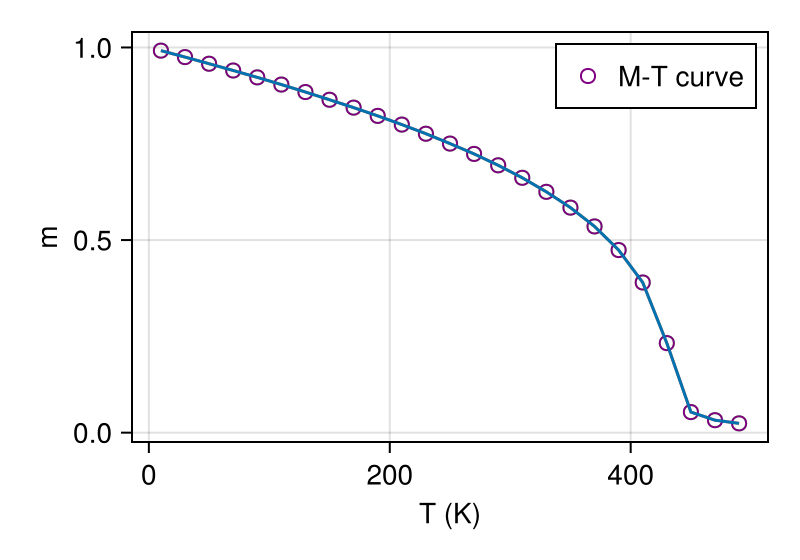M-T curve using Monte Carlo
In MicroMagnetic, we can use Monte Carlo to compute the M-T curve. For the atomistic model with
where
julia
using MicroMagnetic
#MicroMagnetic.set_float(Float32)
@using_gpu()
function relax_system_single(T)
mesh = CubicMesh(; nx=30, ny=30, nz=30, pbc="xyz")
sim = MonteCarlo(mesh; name="mc")
init_m0(sim, (0, 0, 1))
add_exch(sim; J=300 * k_B)
add_dmi(sim; D=0)
add_zeeman(sim; Hx=0, Hy=0, Hz=0)
add_anis(sim; Ku=0, Kc=0)
sim.T = 100000
run_sim(sim; max_steps=10000, save_vtk_every=-1, save_m_every=-1)
sim.T = T
run_sim(sim; max_steps=50000, save_vtk_every=-1, save_m_every=-1)
ms = zeros(1000)
sim.T = T
for i in 1:1000
run_sim(sim; max_steps=100, save_vtk_every=-1, save_m_every=-1)
t = MicroMagnetic.average_m(sim)
ms[i] = sqrt(t[1]^2 + t[2]^2 + t[3]^2)
end
return sum(ms) / length(ms)
end
function relax_system()
f = open("M_T.txt", "w")
write(f, "#T(K) m \n")
for T in 10:20:20
println("Running for $T ...")
m = relax_system_single(T)
write(f, "$T $m \n")
end
return close(f)
endRun the relax_system function.
julia
relax_system()Finally, we plot the M-T curve.
julia
using DelimitedFiles
using CairoMakie
function plot_m_H()
fig = Figure(; size=(400, 280), backgroundcolor = :transparent )
ax = Axis(fig[1, 1]; xlabel="T (K)", ylabel="m", backgroundcolor = :transparent)
data = readdlm("M_T.txt"; skipstart=1)
sc1 = scatter!(ax, data[:, 1], data[:, 2]; markersize=10, label="M-T curve")
sc1.color = :transparent
sc1.strokewidth = 1
sc1.strokecolor = :purple
lines!(ax, data[:, 1], data[:, 2])
axislegend()
#save("M_T.png", fig)
return fig
end
fig = plot_m_H();
[1] Atomistic spin model simulations of magnetic nanomaterials, J. Phys.: Condens. Matter 26 (2014) 103202.